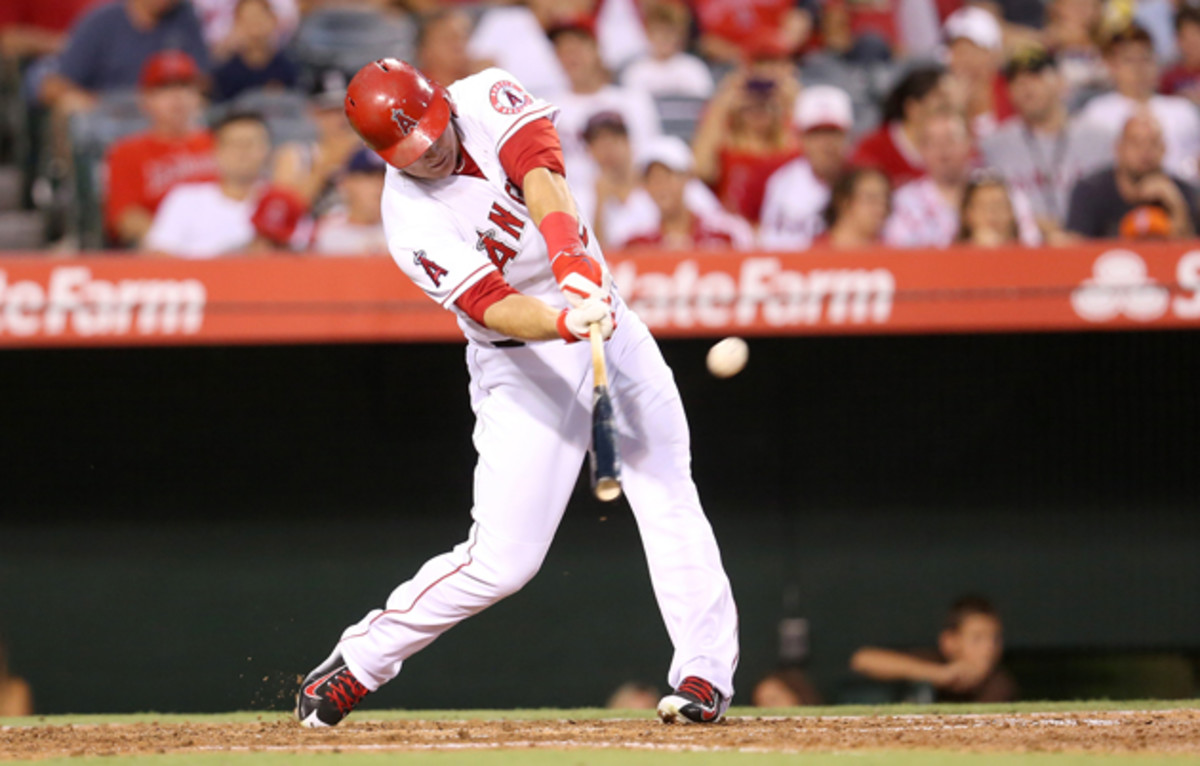Out of the box: Mike Trout's explosive training secret

Mike Trout may be having an off year, but the Angels slugger will probably still win the AL’s MVP award. That’s how good the 23-year-old Trout is. The Millville Meteor, as the centerfielder is known, was drafted by the Angels out of Millville (N.J.) High in 2009, before he could fulfill a commitment to play for East Carolina. Since his arrival in the majors, he has been putting up historic numbers, winning the 2012 AL Rookie of the Year Award and twice finishing runner-up in MVP voting.
Trout may be one the most precocious talents to grace the game in decades, but the young Prince Fish, as the player is also known, has had some help swimming upstream. Chief among those who have contributed to Trout’s success is his high-school trainer, Dan Richter, who still works with the three-time All-Star in the off-season in New Jersey.
But how do you train an athletic phenom like Trout, who seems to have been born to hit a ball, to an even greater level of stardom?

For Richter, the answer ends with a bat and starts with a box—or box jumps, Trout’s bread-and-butter workout of the off-season. But the two-time Silver Slugger is not satisfied by just any ordinary 12-inch jump.
“Fifty-inch box jumps are easy for him, so I have him hold dumbbells in his hands or weight plates,” says Richter. “Or I put four boxes in a circle and have him jump up on them. I have to tweak normal exercises like this because the average stuff just won’t him help—he’s so above and beyond the average.”
The 10 Key Weight Training Exercises for Major League Baseball
And with exceptional athletes come exceptional workouts. Trout and Richter train together six days a week in the off-season, and each day comes with its own distinct challenge, says Richter.
Mondays, for example, start with 15 minutes of dynamic warm-up, during which Trout performs functional stretches such as skips, shuffles, high knees, and lunges to ready his muscles for action. Then, the workout begins: ten 30-second sprints on a treadmill, Trout jumping off between sprints to do some box jumps; 500 feet of climbing on a Versatrainer, Trout jumping off intermittently to do step-ups with a 45-pound plate in hand; 300-yard test sprints, Trout typically running them in a minute or less; and then core work with foam rolling and flexibility exercises. Finally, after an hour and a half, Trout packs it in for the day before hitting the repeat 24 hours later for Tuesday’s workout.
“I really can’t see too many other guys in the league going as many days as he does and as hard as he does,” Richter says of Trout’s off-season training. “When he comes to the gym, it’s all business for an hour and a half. He goes hard, and it’s a priority for him. I think that’s a rarity for other guys. I think he’s the exception to the rule.”
If Trout’s work ethic is exceptional, his training is as well. Richter designs Trout’s weekly workouts with a unique mixture of different disciplines that help keep the centerfielder reactive at bat and nimble in the field. So while other players may spend time solely in the weight room over the off-season, Trout is mixing high-level aerobic endurance work with anaerobic speed, Olympic-style lifting with bodyweight exercises, plyometrics with TRX training, and core work with mobility exercises. And, of course, he is doing his box jumps, too, at least several times per week, which Richter says can have a huge impact come the season.
San Diego Padres pitcher Alex Torres still sporting protective cap
“I think the explosiveness [from box jumps] gives him that little edge for getting the ball on the wall compared to not getting the ball on the wall,” the trainer says. “It helps give him the agility to leap up at balls and get them down without getting hurt.”
Yet honing Trout’s explosiveness through box jumps mandates a different routine almost every other day. “It’s innovative box jumps at innovative times,” Richter says of Trout’s training. “I’ll have him do box jumps after pull-ups or he’ll do them up onto a Bosu ball. Or at the end of an hour-and-a-half workout, I’ll stack a few boxes together and have him jump on top of them. To me, box jumps just work everything—you get your strength component in there, you get your power component in there, and you have to have a strong core. It’s an overall exercise. And doing them in different ways gives him something to think about.”
“Since Mike started training with me, I have been telling him how important hydration is both while training, during recovery and during his play in baseball games and BODYARMOR is Mike’s primary source of hydration," says Richter. Trout is also a stakeholder and ambassador for the growing sports drink brand.
When Trout’s season with the Angels starts, his box jumping ends, and his attention turns to his performance on field. But the work ethic that makes a man want to jump up onto a 50-inch box over and over again never stops, Richter says, adding, “He takes everything hard and goes at everything hard. He’s never going to lay back or take a play off. Even when he’s tired, he is still going 100 percent. And he doesn’t treat it as work—it’s fun for him.”
